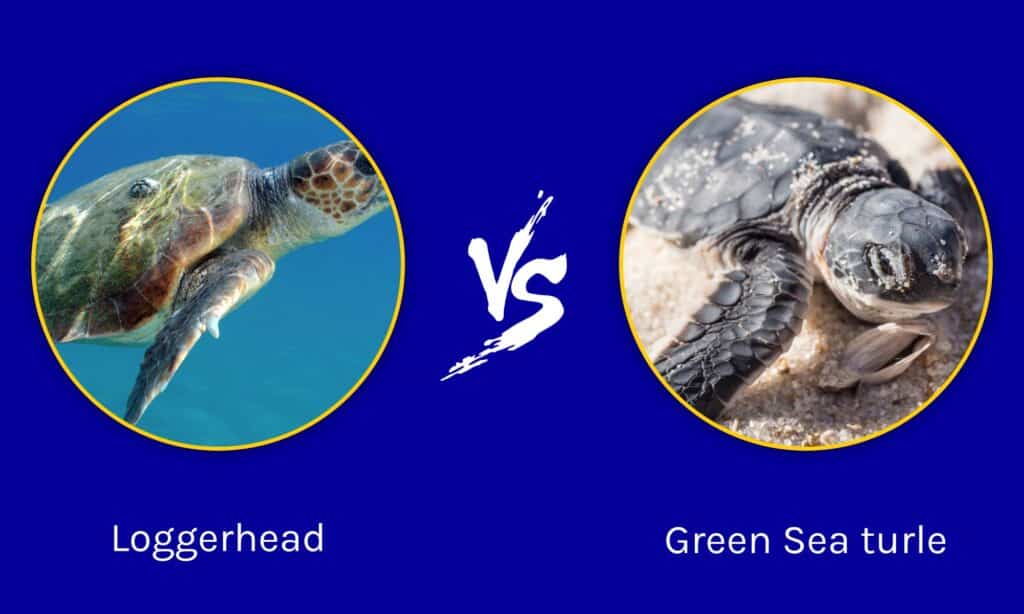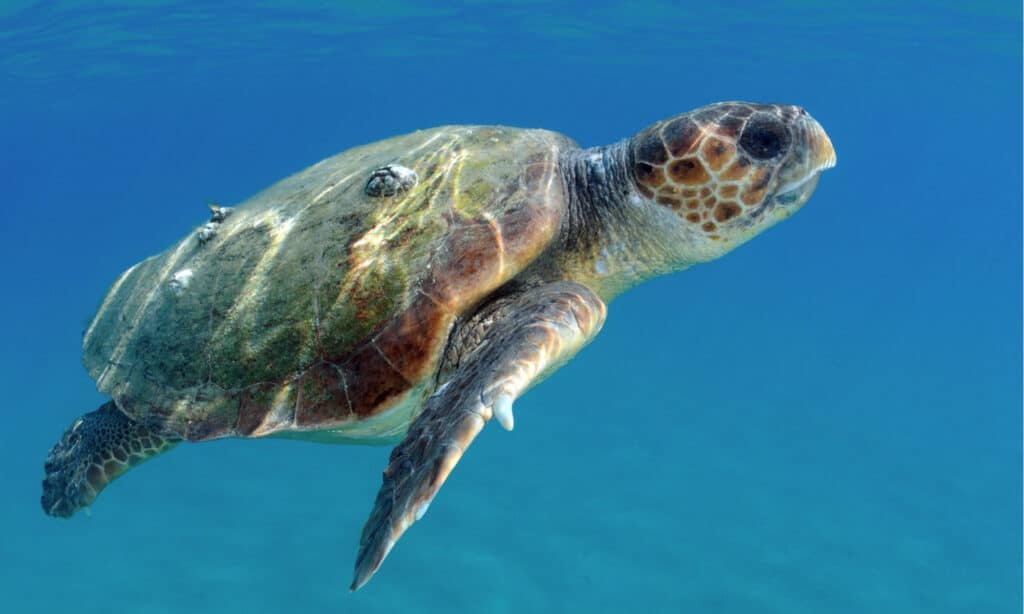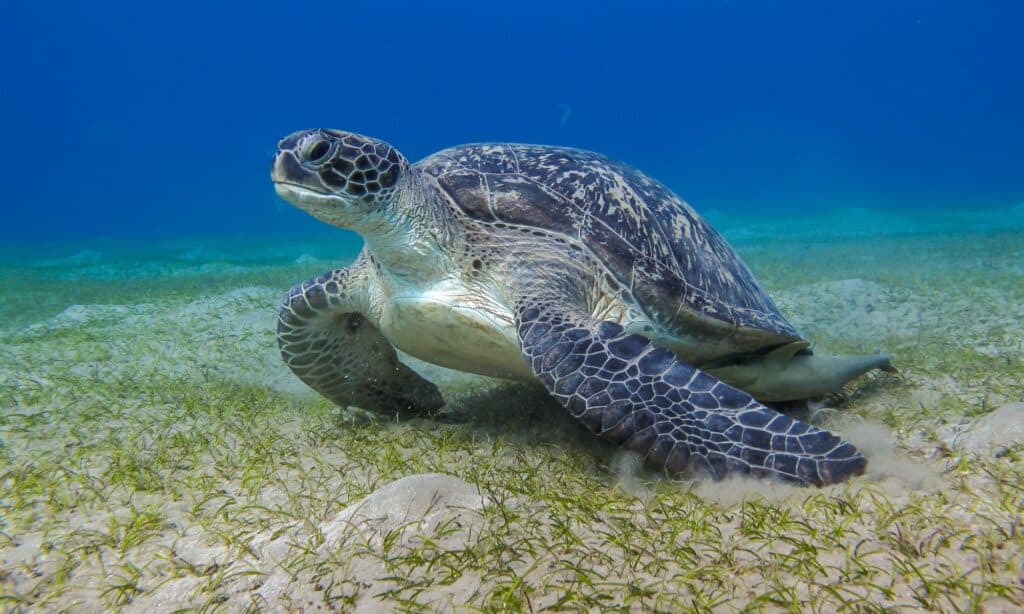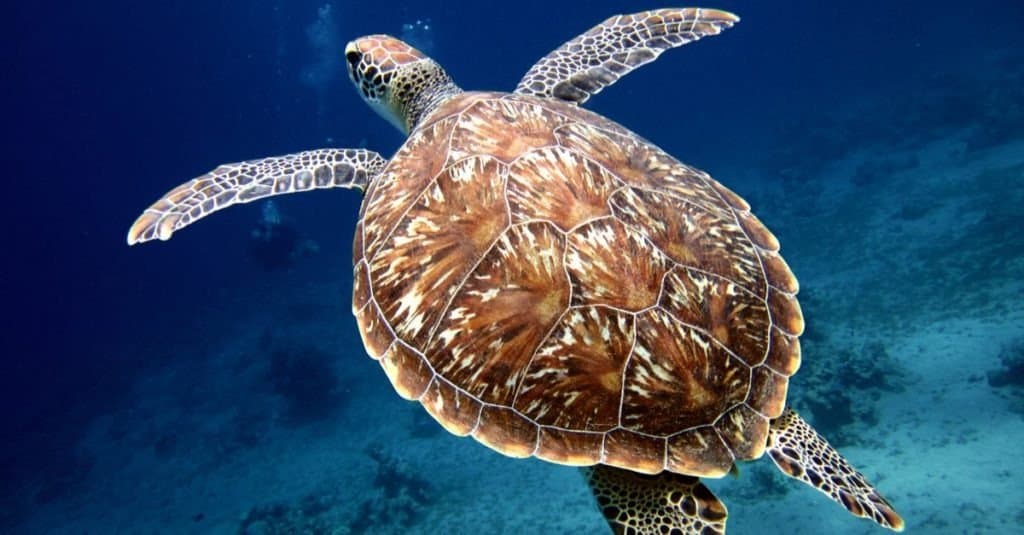Sea turtles are some of the coolest creatures in the ocean! Across the world, seven unique species of sea turtle exist, all of them different. Today, we are going to be taking a closer look at two of them, the loggerhead and the green sea turtle. Although they are quite similar, there are some distinct differences between them. Let’s explore: Loggerhead vs Green Sea Turtle!
Comparing a Loggerhead and a Green Sea Turtle

| Loggerhead sea turtle | Green sea turtle | |
|---|---|---|
| Appearance | Yellow-orange to reddish-brown shell with pale yellow belly. Neck and sides are brown. | Patterned shells, often marbled with variegated rays. Brown, black, or yellowish shell. Spotted brown limbs. |
| Size | World’s largest hard-shelled turtle. 180-440 lbs, average at 289 lbs. Maximum recorded at 1,202 lbs. | 150-419 lbs, with a maximum of 871 lbs. |
| Distribution | Broadest range of any sea turtle. Atlantic, Indian, and Pacific Oceans, Mediterranean Sea. | Tropical and subtropical oceans worldwide. Two distinct populations in the Atlantic and eastern Pacific. |
| Habitat | Prefer open ocean and shallow coastal waters. Hatchlings live in floating vegetation mats. | Three-staged habitat as they mature. Adults are found in shallow coastal seagrass beds. |
| Diet | Omnivorous. Mostly bottom-dwelling invertebrates. | Begin life as carnivorous, but turn herbivorous as they mature. |
| Conservation status | Vulnerable. | Threatened. |
The 6 main differences between a Loggerhead and a Green Sea Turtle
The main differences between a loggerhead and a green sea turtle are that loggerheads are larger and are omnivorous, while green turtles are smaller and herbivorous.
Generally, sea turtles are similar, no matter the species. Still, as any wildlife nerd knows, no animals are exactly alike when you take a closer look at them. The loggerhead and the green sea turtle are no exception! Despite the differences in name, these two turtles look quite similar. Green sea turtles aren’t actually green. Instead, they get their name from the layer of green fat they develop under their shells. One of the best ways to tell the difference between a loggerhead and a green turtle is the head proportions. Loggerheads have much larger heads in proportion to their bodies.
Aside from appearances, these two turtles are different in size. Loggerheads are the largest hard-shelled turtle in the world, second only to the leatherback turtle for the largest turtle in the world. The largest loggerhead ever seen weighed 1,202 lbs. Green sea turtles are also large, just not as large as loggerheads. Most green sea turtles weigh 200-300 lbs, with the largest individual ever seen weighing 871 lbs.
Loggerheads and green sea turtles also differ in their habitat preferences, diets, and conservation status. Let’s explore these in some more detail below!
Loggerhead vs Green Sea Turtle: Appearance
The similarities in appearance between the loggerhead, green, and hawksbill sea turtles can make identification difficult, especially when their distributions overlap. Still, there are some distinctions that can be helpful. Loggerheads have larger heads in proportion to their bodies. Additionally, loggerheads have heart-shaped shells with five or six large scutes (shell segments) on either side of their smaller dorsal (spinal) scutes.
Green sea turtles have similar colorations to the loggerhead, despite their name. In fact, green sea turtles aren’t green at all, getting their name from the color of the fat under their shells. Green sea turtles have round shells with four lateral scutes on each side of their shell.
Loggerhead vs Green Sea Turtle: Size

Loggerhead turtles are generally larger than green sea turtles.
©Matteo photos/Shutterstock.com
One of the major differences between loggerheads and green turtles is their size. Loggerheads are the second-largest turtles in the world and the largest hard-shelled turtles on earth. The leatherback turtle is larger, but its softer shell allows it to grow bigger by comparison. On average, loggerheads reach 180-440 lbs. The average loggerhead usually weighs 289 lbs. The largest loggerhead ever recorded weighed an incredible 1,202 lbs.
The green sea turtle is smaller than the loggerhead, but they are still large creatures! On average, the green turtle weighs 150-419 lbs, putting them in third place among other sea turtle species. The largest green sea turtle ever seen weighed 871 lbs.
Loggerhead vs Green Sea Turtle: Distribution

The loggerhead turtle has the widest distribution of any sea turtle.
©iStock.com/YasserBadr_Beenthere
Loggerhead turtles are extremely widespread and have the widest distribution of any sea turtle species. These turtles can be found in the Atlantic, Pacific, and Indian Oceans, as well as the Mediterranean Sea. Essentially, the loggerhead can be found in any ocean across the world between the attitudes of South Africa and Scotland.
Green sea turtles prefer tropical and subtropical oceans around the world. Within their distribution are two distinct groups, the Atlantic and eastern Pacific subpopulations. There are genetic differences between the groups, although they are still classified together. The largest populations in the United States can be found around coastal Florida and Hawaii, and the largest populations in the world are found in the Great Barrier Reef and the Caribbean Sea.
Loggerhead vs Green Sea Turtle: Habitat

Green sea turtles spend most of their adult lives in large seagrass meadows.
©Isabelle Kuehn/Shutterstock.com
The loggerhead turtle prefers the open ocean and shallow waters near the shore. They often alternate between the two, depending on their feeding patterns. When loggerheads are still young, they often live within large algae mats of Sargassum in order to keep out of predator’s reach.
Green sea turtles have a varied habitat that mostly depends on their stage of life. Still, most green sea turtles can be found near the coast, primarily in seagrass meadows underwater. As a result, they frequent lagoons, bays, and shoals where seagrass is present.
Loggerhead vs Green Sea Turtle: Diet

Loggerheads are omnivorous, while green sea turtles are mostly herbivorous.
©Kjeld Friis/Shutterstock.com
The loggerhead is omnivorous. Most of their diet comes from bottom-dwelling invertebrates. Their primary sources of food include sponges, corals, anemones, starfish, fish, jellyfish, squid, gastropods, and bivalves. They have the largest known prey list of any other sea turtle species.
The green sea turtle has a unique diet that changes as they age. When they are young, baby turtles are almost entirely carnivorous and eat fish eggs, jellyfish, sponges, and crustaceans. As they age, however, they shift to eating algae and seagrass. Their diets of seagrass likely cause the green fat that gives them their name.
Loggerhead vs Green Sea Turtle: Conservation status

Every species of sea turtle is listed as endangered.
©Magdalena Paluchowska/Shutterstock.com
All sea turtles across the world are at risk in some way or another. Currently, the loggerhead turtle is listed as Vulnerable by the IUCN and the WWF. Green sea turtles are listed as Endangered by the IUCN and the WWF. Both populations face threats from human poaching, habitat loss, pollution, and egg destruction.
The photo featured at the top of this post is © iStock.com/Greg Sullavan
Thank you for reading! Have some feedback for us? Contact the AZ Animals editorial team.






